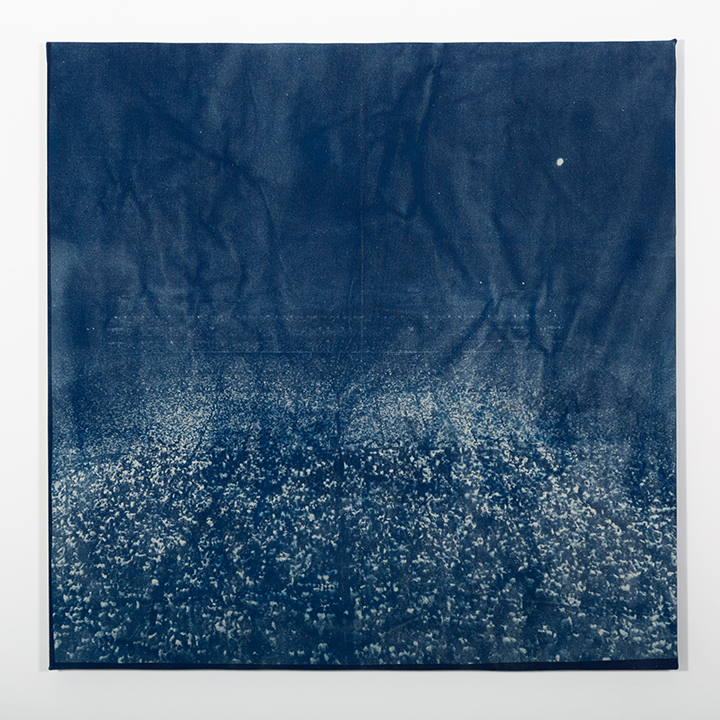
Assistant Professor of Emerging Media Arts Jesse Fleming’s latest body of work, titled “NUCLEI,” was recently on display at Five Car Garage, a contemporary art gallery located in Santa Monica, California.
For this new body of work, Fleming presented a series of large-scale cyanotype prints and a projected work; a generative particle simulation evolving based on the behavior of surrounding “crowds.” Both works evoke huge tribal groupings of humanity gathering and connecting at a time when solitude and isolation has been enforced on all societies around the globe. Yet from the solitude, crowds continue rupturing into formations and this work reveals a precarious choice of outcome, dependent on the behavior of the crowd itself, the nuclei, for regression, reform, and perhaps reverence.
“I’ve been doing work around individual vs collective identity since my first solo show nearly 20 years ago,” Fleming said. “This particular project started with a curiosity of what a gathering might look and feel like if the spectacle were removed? It was my way of pointing backwards to the potentially overlooked draw of large scale events—the collectivity. The Huskers games, for example, there is the sporting event, and there is also the massive sensation of togetherness. This was my way of isolating that sensation. And I found the emotion of the images was very strong and very divergent. Sometimes awe-inspiring, sometimes fear-evoking. That’s something that has also played out for all time—the collective potential and the different outcomes that can take. Between the Covid-19 pandemic and the upcoming climate driven migrations, these images seemed resonant of so much that is now.”
For the cyanotypes, Fleming uses hand collage to remove the spectacle of large scale gatherings, and scrubs the image of identifying symbols or advertisements while the process of hand collage, sometimes revealing tape or cut marks is revealed. The tell of manipulation points to the intention of removing the spectacle and in turn, points to a new way of seeing a mass gathering as the group itself. The prints stand as an agitator — challenging one’s affective response to groups, gatherings, and celebration. It is perhaps a matter of trust, culture, and identity that promotes a variable reaction of agoraphobia to solidarity. The images are then scanned and enlarged to a scale that brings the viewer into a direct experience with the scene, superimposing and feeling themselves within the event, large negatives are created, and eventually exposed as cyanotypes using the inevitable unpredictability of the sun, creating a series of unique images.
“The cyanotype prints were all made here at UNL and due to the chemicals or the varying characteristics of the sun on the day and time of exposure, they are always unique; not unlike each festival or sporting event,” Fleming said.
In the accompanying particle simulation, the activity is infinitely changing and appears held in an architecture-like a stadium without walls. Here, Fleming creates an event referential of the printed crowd scenes, yet like the 1977 Eames film Powers of Ten, the division between micro and macro is replaced by a peculiar awe, a sense of echoing similarity between all scales of life; actions from crowds, like starlings swarms, to far-off galaxies, or to the internal state of pulsing atoms.
Fleming directs The Perpetual Technologies Lab (PTL) at the Johnny Carson Center for Emerging Media Arts, an interdisciplinary laboratory supporting emerging media art and extended reality development through the lens of mindfulness. The particle simulation in the exhibition was developed in this lab.
“We studied the physics of stadium waves and found the research showed that it only takes about 15-20 people to incite a wave that picks up thousands and becomes an emergent property without prediction,” Fleming said. “In this setting and scale, people behave like particles; so we designed a simulation with the color tones of the prints and a location we designed as an invisible stadium without any center. The data is the architecture and within that architecture the particle waves are randomly and generated or forever influencing the behavior of neighboring particles. The simulation seemed to complete the show in a way that brought a meta relationship to the images—a scaling of people to microbes, to cosmos—all entangled systems.”
Fleming is an award-winning and internationally exhibited artist and filmmaker. His work has shown at commercial galleries, public spaces, nonprofit galleries and cultural institutions. He has taught at the University of Nebraska–Lincoln since 2019.
To view an excerpt from the particle simulation that accompanies “Nuclei,” visit https://go.unl.edu/p4h6.
To see more images from the exhibit, visit https://go.unl.edu/by60.